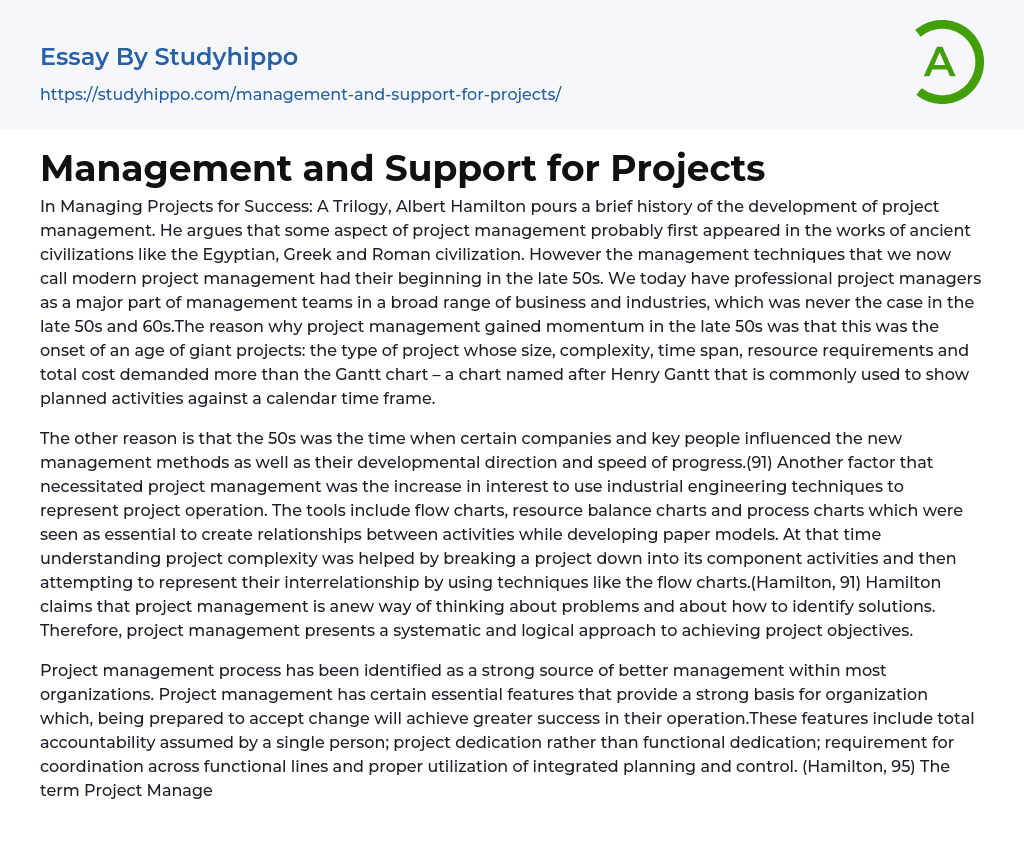Albert Hamilton's book "Managing Projects for Success: A Trilogy" provides a brief history of project management. According to Hamilton, ancient civilizations like the Egyptians, Greeks and Romans may have utilized some aspects of project management. However, it wasn't until the late 50s that modern project management techniques emerged. Since then, professional project managers have become integral members of various industries' management teams.
The late 50s marked the beginning of an era of massive projects that required more than just Gantt charts - a tool commonly used to illustrate planned activities against a time frame. These projects were characterized by their size, complexity, time span, resource requirements and total cost.
The 50s saw the emergence of new management methods and faster developmental progress, influenced by certain companies and key individuals. This, coupled with the need to use industrial engineering techniques in project operation, made pro
...ject management a necessity. Resource balance charts, process charts and flow charts became essential tools in representing activities and developing paper models. Hamilton suggests breaking down project complexity into its component activities facilitated understanding of the interrelationship between them using techniques such as flow charts. Project management presents a new approach to problem-solving and solution identification in a systematic and logical manner to achieve project objectives.
Many organizations have identified project management as a strong source for better management. There are certain essential features that provide a strong basis for organizations that are prepared to accept change and achieve greater success in their operation. These features include total accountability assumed by a single person, project dedication instead of functional dedication, the requirement for coordination across functional lines, and proper utilization of integrated planning and
control (Hamilton, 95). The sum of knowledge within the profession of project management is described as the Project Management Body of Knowledge (PMBOK), advocated for by the Project Management Institute in the United States. As with other professions, practitioners and academics apply and advance the body of knowledge.
Hamilton (99) states that the Project Management Body of Knowledge consists of traditional practices commonly used and innovative techniques not yet widely adopted. In his book, Project Planning Scheduling and Control: A Hands-on Guide, Lewis claims that the primary objective of a project plan is to achieve project control. Without a plan, managing a project becomes difficult. To attain project control, Lewis emphasizes understanding two essential factors.
The organization's current position and future goals are outlined in their plan, indicating where they should be in a specific timeframe. The project information system, which is often nonexistent, can provide information on the organization's current position. Marshall Engel beck emphasizes the importance of planning for managers; it is the initial step in implementing acquisition decisions and crucial to the project's success. The plan sets objectives for acquisitions, establishing the integrated acquisition team's direction.
Solid planning is crucial for successful acquisitions, as it enables the integrated acquisition team to be proactive rather than reactive. The objectives established during planning act as a guide and benchmark to measure progress along the way. By measuring variance from the desired route, effective management control is established and project leadership can evaluate performance and take corrective action if needed. Acquisition reform initiatives aim to shift the program management mindset from risk aversion to risk management.
(61) According to Marshall, a project's success requires cooperation among various
fields of knowledge, each with their own perspectives and goals. However, professionals and technical specialists may consider themselves as superior and prioritize their own unique values, hindering interdisciplinary collaboration and potentially leading to conflicts that disrupt the project. Therefore, the project manager must oversee the team and create an environment and communication system that fosters unity among all members.
(45) A thorough communication channel is necessary for successful project completion, through both formal and informal means. Effective information exchange is crucial for timely completion and knowledge sharing among specialists involved in the project.
The text consists of a single HTML tag: a paragraph tag
containing the number 45 as its content.
- Accident essays
- Awareness essays
- Benefits of Volunteering essays
- Challenges essays
- Childhood Memories essays
- Decision essays
- Driving essays
- Event essays
- Excellence essays
- Expectations essays
- Failure essays
- Farewell essays
- Flight essays
- Gift essays
- Growing Up essays
- Ignorance essays
- Improve essays
- Incident essays
- Knowledge essays
- Luck essays
- Memories essays
- Mistake essays
- Obstacles essays
- Overcoming Challenges essays
- Party essays
- Peace Corps essays
- Personal Experience essays
- Problems essays
- Sacrifices essays
- Struggle essays
- Success essays
- Trust essays
- Vacation essays
- Visit essays
- Volunteering essays
- Board Of Directors essays
- Brand Management essays
- Business Ethics essays
- Business Management essays
- Change Management essays
- Comparative Analysis essays
- Decision Making essays
- Dispute Resolution essays
- Knowledge Management essays
- Leadership essays
- Leadership and Management essays
- Manager essays
- Operations Management essays
- Performance Management essays
- Product Management essays




